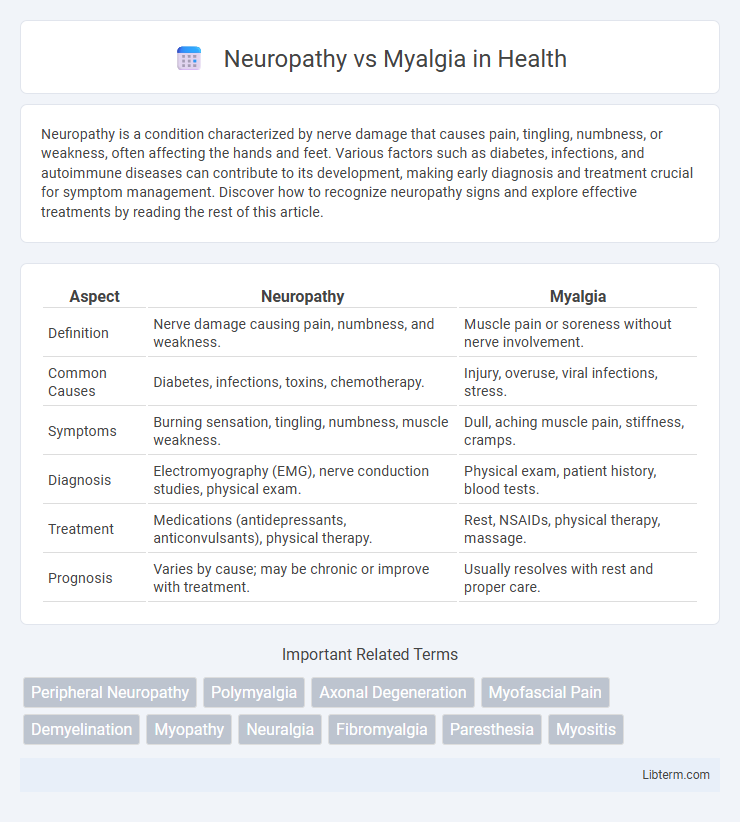Neuropathy is a condition characterized by nerve damage that causes pain, tingling, numbness, or weakness, often affecting the hands and feet. Various factors such as diabetes, infections, and autoimmune diseases can contribute to its development, making early diagnosis and treatment crucial for symptom management. Discover how to recognize neuropathy signs and explore effective treatments by reading the rest of this article.
Table of Comparison
| Aspect | Neuropathy | Myalgia |
|---|---|---|
| Definition | Nerve damage causing pain, numbness, and weakness. | Muscle pain or soreness without nerve involvement. |
| Common Causes | Diabetes, infections, toxins, chemotherapy. | Injury, overuse, viral infections, stress. |
| Symptoms | Burning sensation, tingling, numbness, muscle weakness. | Dull, aching muscle pain, stiffness, cramps. |
| Diagnosis | Electromyography (EMG), nerve conduction studies, physical exam. | Physical exam, patient history, blood tests. |
| Treatment | Medications (antidepressants, anticonvulsants), physical therapy. | Rest, NSAIDs, physical therapy, massage. |
| Prognosis | Varies by cause; may be chronic or improve with treatment. | Usually resolves with rest and proper care. |
Understanding Neuropathy and Myalgia
Neuropathy involves damage or dysfunction of the peripheral nerves, leading to symptoms such as numbness, tingling, and sharp, burning pain often associated with conditions like diabetes or autoimmune diseases. Myalgia refers to muscle pain resulting from muscle injury, inflammation, or overuse, characterized by aching or soreness without nerve involvement. Understanding the distinction between neuropathy's nerve-related symptoms and myalgia's muscle-centric discomfort is crucial for accurate diagnosis and targeted treatment.
Key Differences Between Neuropathy and Myalgia
Neuropathy involves nerve damage causing symptoms such as tingling, numbness, and burning pain, whereas myalgia refers to muscle pain characterized by aching and soreness. Neuropathy is often associated with conditions like diabetes and autoimmune diseases, while myalgia is commonly linked to muscle overuse, injury, or viral infections. Diagnosis of neuropathy relies on nerve conduction studies and electromyography, whereas myalgia is typically assessed through physical examination and patient history.
Common Causes of Neuropathy
Neuropathy commonly arises from diabetes, infections like Lyme disease or shingles, autoimmune disorders such as lupus, and exposure to toxins including chemotherapy drugs and alcohol. Myalgia, in contrast, primarily results from muscle strain, overuse, or viral infections. Understanding the distinct causes helps in accurate diagnosis, with neuropathy involving nerve damage and myalgia characterized by muscle pain.
Common Causes of Myalgia
Myalgia commonly arises from muscle overuse, tension, and minor injuries often linked to strenuous physical activity, viral infections such as influenza, and certain medications including statins. Unlike neuropathy, which stems from nerve damage due to diabetes or autoimmune disorders, myalgia is primarily associated with muscle inflammation and electrolyte imbalances. Identifying the underlying cause of myalgia involves assessing physical strain and systemic conditions that contribute to muscle pain and stiffness.
Signs and Symptoms of Neuropathy
Neuropathy primarily presents with numbness, tingling, and burning sensations often starting in the hands or feet, accompanied by muscle weakness and loss of reflexes. Pain in neuropathy tends to be sharp, stabbing, or electric-like, contrasting with the dull, aching discomfort typical of myalgia. Sensory deficits such as reduced proprioception and impaired temperature sensation are hallmark signs distinguishing neuropathy from muscle-related conditions.
Signs and Symptoms of Myalgia
Myalgia primarily presents as muscle pain, tenderness, and stiffness, often accompanied by soreness and fatigue localized to the affected muscles. Unlike neuropathy, which involves nerve pain, numbness, or tingling, myalgia symptoms typically do not include neurological deficits such as burning sensations or muscle weakness. Common causes of myalgia include muscle strain, injury, infections, and inflammatory conditions, each influencing the intensity and duration of muscle discomfort.
Diagnostic Approaches: Neuropathy vs Myalgia
Diagnostic approaches for neuropathy emphasize nerve conduction studies, electromyography (EMG), and detailed neurological examinations to assess nerve function and pinpoint nerve damage. In contrast, myalgia diagnosis relies primarily on clinical evaluation, including patient history, muscle strength tests, and sometimes creatine kinase (CK) levels to detect muscle inflammation or injury. Imaging techniques like MRI or ultrasound may aid in distinguishing myalgia from neuropathic causes by revealing muscle tissue abnormalities absent in neuropathy.
Treatment Options for Neuropathy
Neuropathy treatment options primarily include medications like anticonvulsants (gabapentin, pregabalin) and antidepressants (duloxetine, amitriptyline) that target nerve pain relief and symptom management. Physical therapy and lifestyle modifications, such as improved glycemic control in diabetic neuropathy, play a crucial role in slowing progression and enhancing quality of life. In severe cases, invasive treatments like nerve blocks or spinal cord stimulation may be considered to reduce chronic neuropathic pain.
Treatment Options for Myalgia
Myalgia treatment options primarily include pain relievers such as NSAIDs and acetaminophen, physical therapy to improve muscle strength and flexibility, and lifestyle modifications like adequate hydration and proper ergonomics. In some cases, muscle relaxants or corticosteroid injections may be prescribed for severe pain and inflammation. Addressing underlying causes such as infections or chronic conditions enhances treatment efficacy and prevents recurrence.
Prevention and Lifestyle Tips
Effective prevention of neuropathy involves managing underlying conditions like diabetes, maintaining proper foot care, and avoiding exposure to toxins or repetitive nerve injuries. For myalgia, regular exercise, proper ergonomic practices, and adequate hydration help reduce muscle strain and inflammation. Both conditions benefit from balanced nutrition, stress management, and avoiding smoking or excessive alcohol consumption to support overall nerve and muscle health.
Neuropathy Infographic

 libterm.com
libterm.com